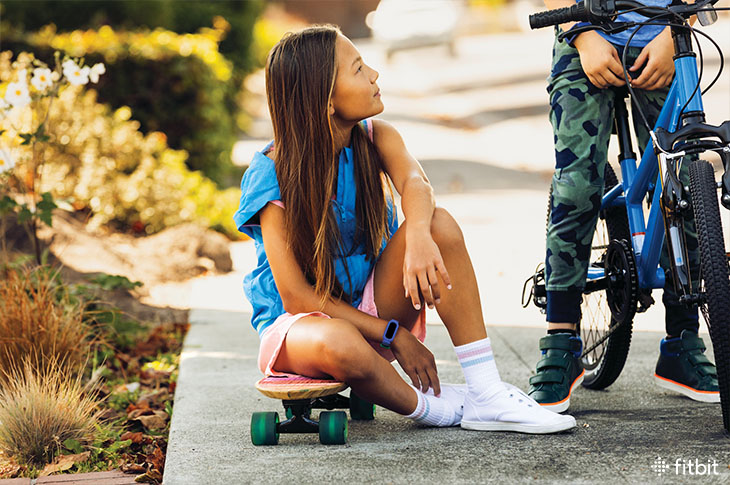
You don’t need to track your screen time to know your usage spiked in the last year. That’s OK and understandable given the circumstances. And now you have great motivation to put down your phone and close your laptop: the weather! Heading outside for a walk, workout, or simply to sit in the park can do wonders for your mood and mental health.
The same goes for preteens and teens. Their screen time increased due to online learning, and, unfortunately, this can exhaust their brains. “Studies have linked excessive use of screen time to higher levels of anxiety and depression,” says Chea Weltchek, LCPC, PMH-C, NCC, a licensed clinical mental health counselor specializing in parenting and children and adolescent behavior. “And with unlimited access to screens and constant engagement comes less ability to focus.” On the other hand, nature has been shown to improve mood and cognition.
If your child’s phone seems super-glued to their hand, no worries. Think about turning something on, rather than off, says Michael Rich, MD, MPH, founder and director of the Digital Wellness Lab at Boston Children’s Hospital. “Change is hard; it’s better to substitute their behavior with something they like to do. Once they start moving, they usually keep it up because it feels physically and mentally better,” he explains.
Try the ideas below to cause your preteen or teen want to go outside.
Give them alternatives. “Invest in toys or equipment that they will be interested in using outside,” suggests Lauren Tingley, a certified parenting coach and creator of Simply Well Balanced, a site with tips on parenting, homemaking, and children’s activities. Consider: bikes, scooters, pogo sticks, trampolines, slacklines, a basketball hoop, or a dog. “All of these items also provide an opportunity for kids to learn a new skill and to get better at it,” Tingley adds.
Start a project they can help with. Choose something that they can use or own, Tingley says. Again, based on your child’s interest, maybe you build a chicken coop, start a vegetable or flower garden, or create a bird feeder. (A quick online search will bring up tons of ideas.) “The trick here is to let them make some of the major decisions and take ownership over the project,” Tingley says. “Our daughter prefers to spend time indoors, but she is happy to be outside working on her ‘she shed’ since she knows she will get to enjoy it in the future.”
Recruit other parents. The parents of your kids’ friends may worry about their teen’s screen time. Call them up and brainstorm exciting group activities your children will enjoy together, suggests Gal Dubnov-Raz, MD, MSc, director of the Exercise, Nutrition, and Lifestyle Clinic at the Edmond and Lily Safra Children’s Hospital, and of the Sports and Exercise Medicine Service at Sheba Medical Center, Israel. Then make a playdate (but don’t call it that, since they’re no longer little kids).
Invite them to join you. The key here is “invite”—you do not force them to do this. But casually mention that you’re going for a picnic, hike, jog, or to try kayaking or anything else and ask if they’d like to come along. They might just say yes.
Casually drop the benefits. When appropriate, slip into conversation the kinds of problems that can be helped by sunlight, fresh air, and exercise, suggests Lorie Anderson, a parenting blogger at MomInformed. “When my son was struggling with acne, I said, ‘Hey, you know that sunlight is really good for your skin. Maybe we could start taking walks together after school.’ He wasn’t receptive to the idea at first, but after sitting with the idea for a few weeks and researching it on his own, he eventually agreed. I noticed him spending more time with his friends outside too.”
Start a challenge. Begin a walking, biking, running, or hiking group with other parents and kids. Then choose a goal to work toward together, such as a 5K or challenging trail. “If kids are with their peers or people outside the regular family members they see all the time, it will spice things up, be more motivating, and provide something to look forward to,” says Anne Bryan, CEO of Circle, a screen time management device to help tame screen time.
Make the connection. “Kids—and adults—sometimes don’t have access to insight around their own feelings,” Weltchek says. “Recognizing that it felt good to be outside can be helpful in connecting the feeling to help them want to be outdoors more in the future.”
But don’t pounce on your kid the second they walk in the door. Instead, maybe at dinner, casually mention how a work project was stressing you out—but after you took a short walk, you felt less frustrated and breezed through the work. You can then ask your child if they’ve noticed anything like that themselves after spending time outside.
Set the example. “Parents have to model the behavior they want to see in their children,” Rich says. If you’re constantly on your phone, you cannot expect your kid to restrict their screen time. Work on your behavior and “do something that shows your kid there’s an alternative to sitting around using screens,” Anderson says.
The post 8 Ways to Get Preteens to Put Down the Phone and Go Outside appeared first on Fitbit Blog.
source https://blog.fitbit.com/preteens-go-outside/
No comments:
Post a Comment